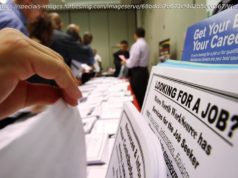Federal Reserve officials signaled rising confidence last month that a strong economy will lift inflation closer to its 2 percent target and that they may accelerate the Fed’s pace of…
WASHINGTON (AP) – Federal Reserve officials signaled rising confidence last month that a strong economy will lift inflation closer to its 2 percent target and that they may accelerate the Fed’s pace of interest rate hikes as a result.
The minutes of the Fed’s March 20-21 meeting, which were released Wednesday, showed that a number of participants believed that a stronger outlook for economic activity plus rising inflation implied that the path for the Fed’s key interest rate in coming years could be “slightly steeper” than expected.
The minutes showed that some Fed officials felt it might eventually choose to revise the Fed’s policy statement to indicate a need to move past an “accommodative” level of rates to one that restrained economic activity slightly to keep inflation in check.
Private analysts noted that this discussion in the minutes marked the first time since the Great Recession that the central bank has discussed the possibility of adjusting interest rates to actually restrain economic growth.
“There it is. The first acknowledgement that they might have to tighten monetary policy, take away the punch bowl, raise interest rates high enough to slow the economy down,” said Chris Rupkey, chief financial economist at MUFG Union Bank of New York.
But analysts noted that this prospect is still down the road, with many still expecting three quarter-point rate hikes this year, the same as last year. The Fed’s next meeting is May 1-2. Analysts think the Fed won’t lift rates then but will wait until June to make another move higher.
At the March meeting, the central bank boosted its key policy rate by a quarter-point to a still-low level of 1.5 percent to 1.75 percent. It kept the same policy language that it has been using since starting to rates in December 2015, namely that it expected to be able to raise rates at a gradual pace in order to achieve the Fed’s policy goal of having inflation rise at an annual rate of 2 percent.
Inflation, by the Fed’s preferred gauge, has persistently fallen below the 2 percent target over the past six years, reflecting a range of factors from the severity of the Great Recession to a temporary dip in global oil prices and a weak global economy.
However, at least some Fed officials believe that inflation has finally begun to move higher.
“A number of participants indicated that the stronger outlook for economic activity, along with their increased confidence that inflation would return to 2 percent over the medium term, implied that the appropriate path for the (Fed’s policy rate) over the next few years would likely be slightly steeper than they had previously expected,” the minutes said.
Indeed, the government reported Wednesday that consumer prices rose 2.4 percent in March compared to a year ago, the fastest 12-month advance in a year and one of several signs that inflation has begun to rise on a sustained basis.
The meeting in March was the first led by Powell, who took over as chairman of the Fed in early February. He succeeds Janet Yellen, who was not offered a second term by President Donald Trump.
The minutes showed that officials had a fairly upbeat view of the economic outlook and believe that a slowdown in consumer spending in the first quarter of this year would be temporary. The officials believed that the $1.5 trillion tax cut that Trump pushed through Congress in December and a February budget deal that increased government spending over the next two years would boost overall growth.
However, officials expressed concerns about the potential economic impact of Trump’s trade policies, which feature higher tariffs to punish countries the president has accused of violating global trade rules.
“A strong majority of participants views the prospect of retaliatory trade actions by other countries… as downside risks for the U. S. economy,” the minutes said.
Copyright 2018 The Associated Press. All rights reserved. This material may not be published, broadcast, rewritten or redistributed.






